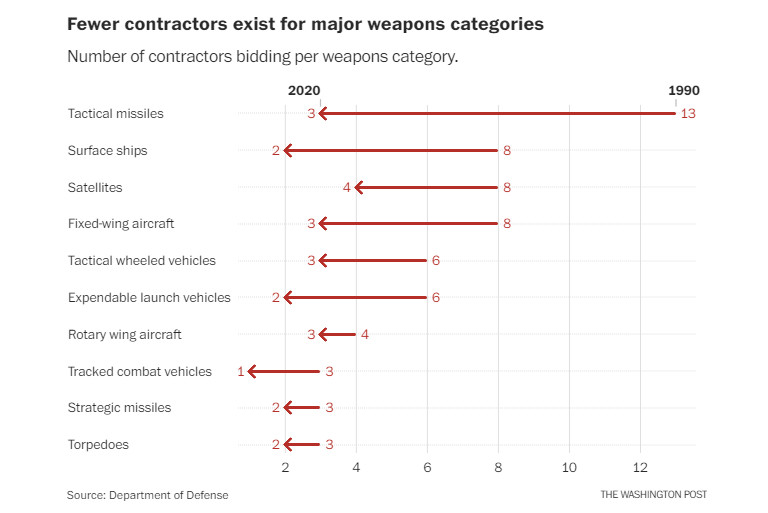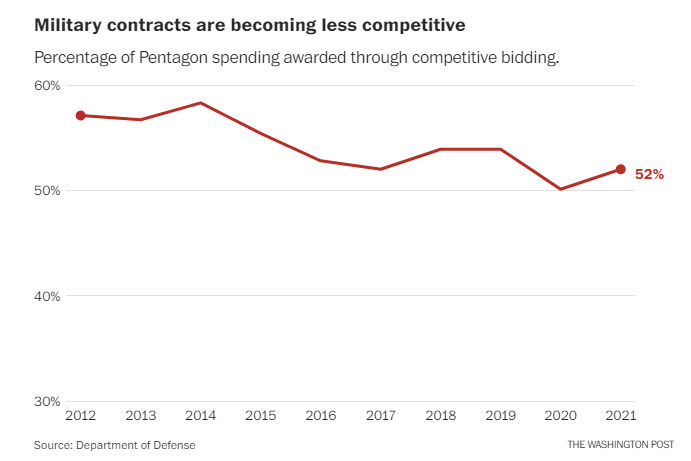
OVERVIEW
MANAGEMENT
PERFORMANCE
POSSIBILITIES
CAPITALS
ACTIVITIES
ACTORS
BURGESS
|
MILITARY
SUPPLY CHAIN FAR TOO CONCENBTRATED WP Opinion: An uncompetitive defense industrial base puts the nation at risk 
The Defense Department seal on the lectern before a news conference on Friday in Washington. (Alex Brandon/AP) Original article: https://www.washingtonpost.com/opinions/2023/02/28/pentagon-competition-weapons-ukraine/ Peter Burgess COMMENTARY Peter Burgess | ||
|
THE POST'S VIEW
Opinion An uncompetitive defense industrial base puts the nation at risk
By the Editorial Board February 28, 2023 at 4:52 p.m. EST Is the Pentagon still a competitive enterprise? The numbers tell a different story. And they suggest the nation might be at risk. At last count, only a slender majority of Pentagon spending, about 52 percent, was awarded after competitive bidding. The number of prime arms contractors shrank from 51 in 1950 to five today — Raytheon, Lockheed Martin, General Dynamics, Boeing and Northrup Grumman — and they captured 36 percent of all contracts in 2020. That represents a 71 percent jump since 2015. A larger percentage of Pentagon dollars is going to a smaller number of firms. 
This consolidation of defense industrial base has several roots: After the Cold War, both Congress and the Pentagon encouraged weapons-makers to merge in part to preserve expertise in vital technologies but also help ensure that surviving firms remained solvent. More recently, though, weapons-makers became the targets of M&A firms: Private equity outfits with access to cheap capital shopped aggressively for smaller contractors and stray units of the big arms-makers and created holding companies as a way to build value for investors. Finally, a brief slowdown in the growth of defense spending during the past decade might have pushed some companies out of the sector. The results are plain to see. Since 1990, the number of companies that make military-grade, fixed-wing aircraft has been reduced from 8 to 3; satellite makers have dropped from 8 to 4; surface ships from 8 to 2; Firms that make tactical missiles, a linchpin of Ukraine’s defense in the past year, have dropped from 13 to 3. And companies that make the solid rocket motors that often power those missiles, which numbered 5 in 1950, now number two. We have consolidated our way into trouble. 
Having fewer companies that can make an Air Force tanker or an Army truck does not automatically inflate prices, but it rarely serves to lower them. Pentagon acquisition bosses cannot bargain hard for better deals when only one American company makes this sonar buoy or that torpedo. But the real danger of a thinner defense industrial base is that it reduces incentives for innovation, clogs up supply chains for everyone (because fewer companies are around to make the supplies) and renders it almost impossible to ramp up production in an emergency. Roughly 50 years after the broad decline in America’s industrial base began, the ability to make certain products (like casting and forgings, vital in arms manufacturing) is in short supply, as is depth in the skilled trades that make them possible. The Pentagon has done a good job of professionalizing its acquisition teams — the people who work for the taxpayers to make sure the firms deliver weapons systems on time and on budget. Aware of the risks of relying on a smaller number of suppliers, the uniformed services have also begun to hold routine Silicon Valley-style pitch days, hackathons and prize competitions to meet certain military requirements, hoping to bring start-ups, commercial firms and smaller companies into the industrial base. These steps have helped to both circumvent the steady-as-she-goes instincts of the prime contractors and the services’ own sometimes-sclerotic bureaucracies. But they so far involve only tiny numbers when compared to the Pentagon’s $857 billion budget this year. We encourage those inside the Pentagon to continue their disruption of the old ways of doing business with only the biggest firms. Congress must help the Pentagon field acquisitions experts who can identify and foster a bigger “farm team” of nonmilitary contractors, new entrants and commercial manufacturers — who can move into weapons research and development and emerge as prime and subprime contractors a decade or two from now. And the Pentagon should work more closely with the Federal Trade Commission and the Justice Department’s antitrust divisions to cast a skeptical eye on further defense mergers. We recognize that expanding the defense industrial base will require a much bigger, whole-of-government approach than has been taken to date. We realize that some foreign countries are working hard to deprive this one of the key materials we need, as well as the future markets for the systems we design and procure. And we know it will take time and capital to reverse a generation-long demobilization that appeared to be a good idea at the time. But we should not wait for a national emergency to start. -------------------------------------- The Post’s View | About the Editorial Board Editorials represent the views of The Post as an institution, as determined through debate among members of the Editorial Board, based in the Opinions section and separate from the newsroom. Members of the Editorial Board and areas of focus: Opinion Editor David Shipley; Deputy Opinion Editor Karen Tumulty; Associate Opinion Editor Stephen Stromberg (national politics and policy, legal affairs, energy, the environment, health care); Lee Hockstader (European affairs, based in Paris); David E. Hoffman (global public health); James Hohmann (domestic policy and electoral politics, including the White House, Congress and governors); Charles Lane (foreign affairs, national security, international economics); Heather Long (economics); Associate Editor Ruth Marcus; and Molly Roberts (technology and society). Also on the Editorial Board’s agenda
| The text being discussed is available at | https://www.washingtonpost.com/opinions/2023/02/28/pentagon-competition-weapons-ukraine/ and |